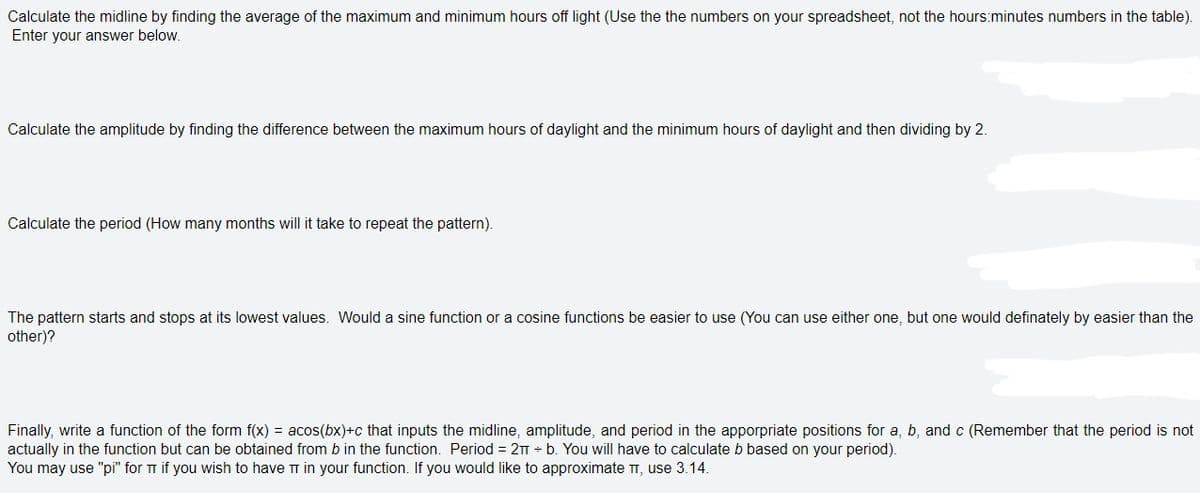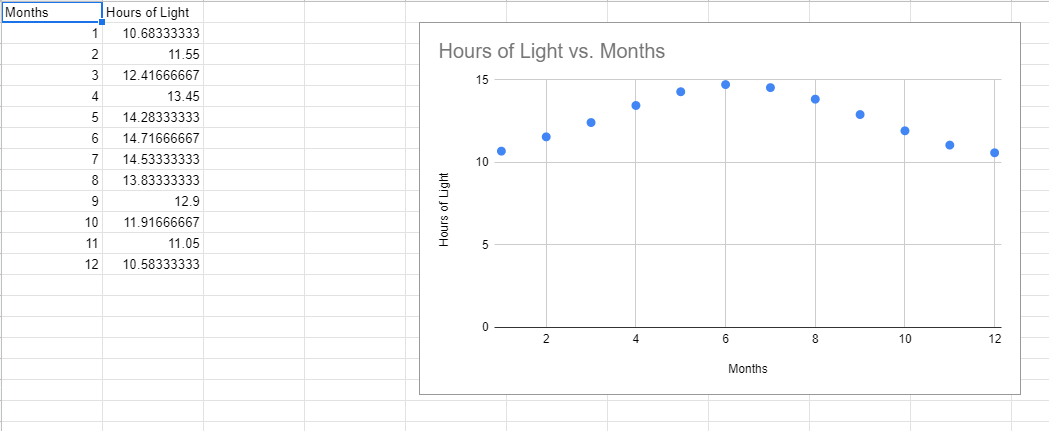Calculate the midline by finding the average of the maximum and minimum hours off light (Use the the numbers on your spreadsheet, not the hours:minutes numbers in the table). Enter your answer below. Calculate the amplitude by finding the difference between the maximum hours of daylight and the minimum hours of daylight and then dividing by 2. Calculate the period (How many months will it take to repeat the pattern). The pattern starts and stops at its lowest values. Would a sine function or a cosine functions be easier to use (You can use either one, but one would definately by easier than the other)? Finally, write a function of the form f(x) = acos(bx)+c that inputs the midline, amplitude, and period in the apporpriate positions for a, b, and c (Remember that the period is not actually in the function but can be obtained from b in the function. Period = 2T + b. You will have to calculate b based on your period). You may use "pi" for TT if you wish to have TT in your function. If you would like to approximate TT, use 3.14.
Calculate the midline by finding the average of the maximum and minimum hours off light (Use the the numbers on your spreadsheet, not the hours:minutes numbers in the table). Enter your answer below. Calculate the amplitude by finding the difference between the maximum hours of daylight and the minimum hours of daylight and then dividing by 2. Calculate the period (How many months will it take to repeat the pattern). The pattern starts and stops at its lowest values. Would a sine function or a cosine functions be easier to use (You can use either one, but one would definately by easier than the other)? Finally, write a function of the form f(x) = acos(bx)+c that inputs the midline, amplitude, and period in the apporpriate positions for a, b, and c (Remember that the period is not actually in the function but can be obtained from b in the function. Period = 2T + b. You will have to calculate b based on your period). You may use "pi" for TT if you wish to have TT in your function. If you would like to approximate TT, use 3.14.
Algebra & Trigonometry with Analytic Geometry
13th Edition
ISBN:9781133382119
Author:Swokowski
Publisher:Swokowski
Chapter6: The Trigonometric Functions
Section6.3: Trigonometric Functions Of Real Numbers
Problem 67E
Related questions
Question
See graph to answer questions.

Transcribed Image Text:Calculate the midline by finding the average of the maximum and minimum hours off light (Use the the numbers on your spreadsheet, not the hours:minutes numbers in the table).
Enter your answer below.
Calculate the amplitude by finding the difference between the maximum hours of daylight and the minimum hours of daylight and then dividing by 2.
Calculate the period (How many months will it take to repeat the pattern).
The pattern starts and stops at its lowest values. Would a sine function or a cosine functions be easier to use (You can use either one, but one would definately by easier than the
other)?
Finally, write a function of the form f(x) = acos(bx)+c that inputs the midline, amplitude, and period in the apporpriate positions for a, b, and c (Remember that the period is not
actually in the function but can be obtained from b in the function. Period = 2TT - b. You will have to calculate b based on your period).
You may use "pi" for TT if you wish to have T in your function. If you would like to approximate TT, use 3.14.

Transcribed Image Text:Months
|Hours of Light
1
10.68333333
2
11.55
Hours of Light vs. Months
3
12.41666667
15
13.45
5
14.28333333
6
14.71666667
7
14.53333333
10
8.
13.83333333
9
12.9
10
11. 91666667
11
11.05
12
10.58333333
2
6
8
10
12
Months
Hours of Light
Expert Solution
This question has been solved!
Explore an expertly crafted, step-by-step solution for a thorough understanding of key concepts.
This is a popular solution!
Trending now
This is a popular solution!
Step by step
Solved in 2 steps with 1 images

Knowledge Booster
Learn more about
Need a deep-dive on the concept behind this application? Look no further. Learn more about this topic, algebra and related others by exploring similar questions and additional content below.Recommended textbooks for you

Algebra & Trigonometry with Analytic Geometry
Algebra
ISBN:
9781133382119
Author:
Swokowski
Publisher:
Cengage

Mathematics For Machine Technology
Advanced Math
ISBN:
9781337798310
Author:
Peterson, John.
Publisher:
Cengage Learning,

Holt Mcdougal Larson Pre-algebra: Student Edition…
Algebra
ISBN:
9780547587776
Author:
HOLT MCDOUGAL
Publisher:
HOLT MCDOUGAL

Algebra & Trigonometry with Analytic Geometry
Algebra
ISBN:
9781133382119
Author:
Swokowski
Publisher:
Cengage

Mathematics For Machine Technology
Advanced Math
ISBN:
9781337798310
Author:
Peterson, John.
Publisher:
Cengage Learning,

Holt Mcdougal Larson Pre-algebra: Student Edition…
Algebra
ISBN:
9780547587776
Author:
HOLT MCDOUGAL
Publisher:
HOLT MCDOUGAL